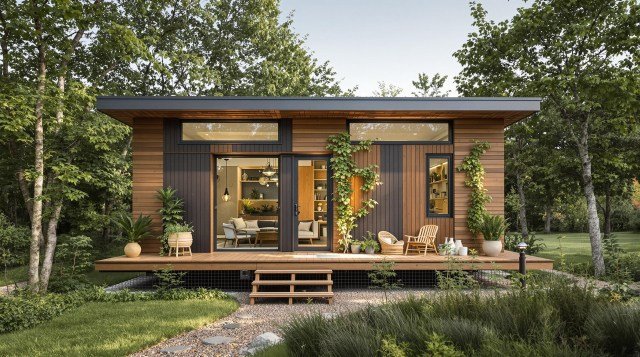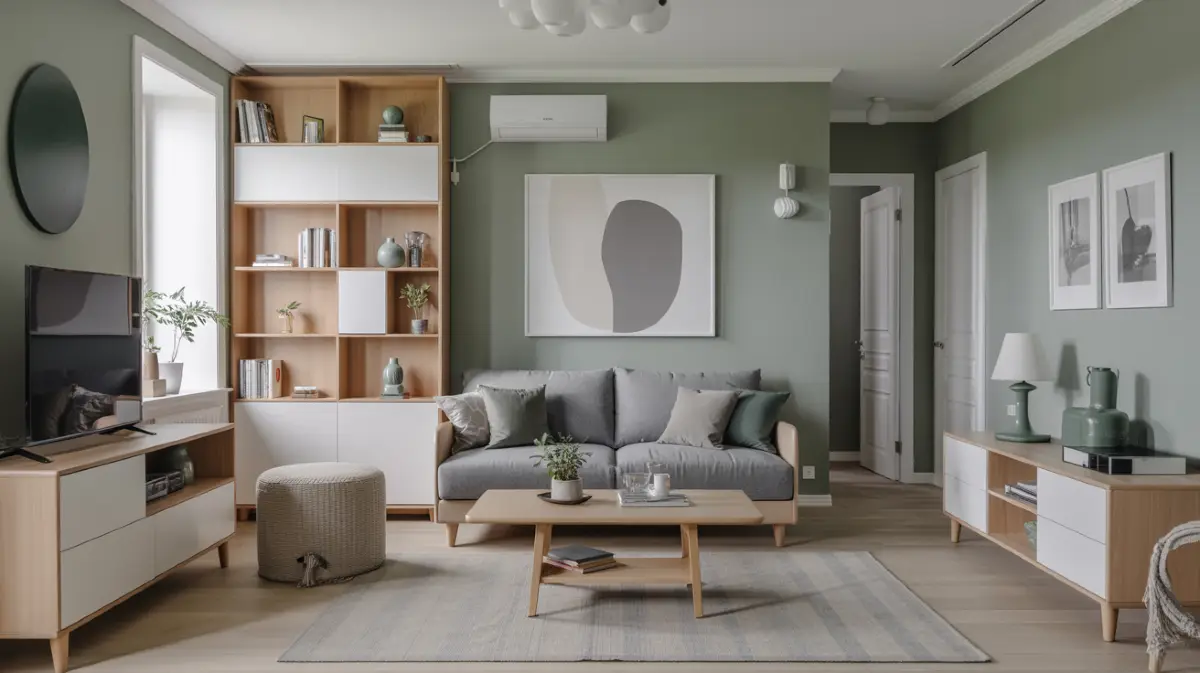
I’ll be honest, I often just stand and stare at my living room. I’m always trying to achieve that clean, minimalist look. But it usually just ends up feeling… well, empty. A little cold, you know?
It’s so hard to make a space feel warm when you’re actively trying to own less. I mean, isn’t that the real struggle? You want simplicity, but you desperately crave comfort.
I’m not sure there’s one single answer, but Scandinavian design gets closer than anything else I’ve found. It’s built on that perfect, cozy-minimalist balance. So, I’ve gathered 18 beautiful ideas that finally make minimalism feel like a real, welcoming home.
1. The Luminous All-White Haven
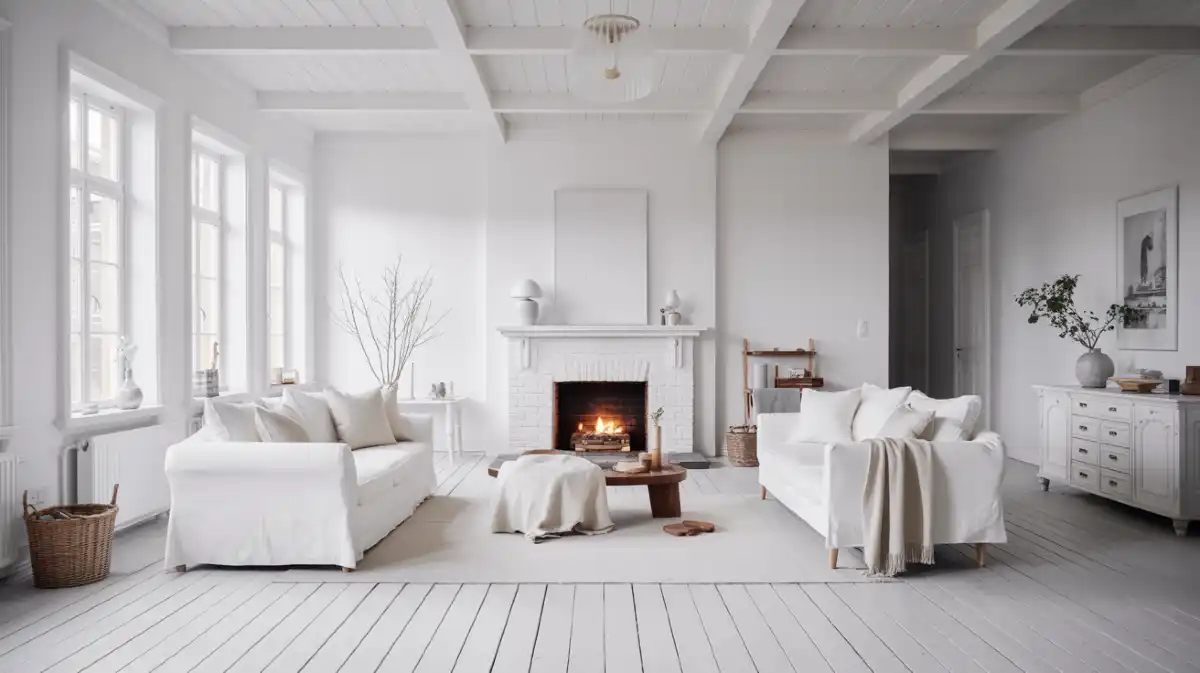
This design is a masterclass in using a monochromatic white palette without it feeling cold or sterile. It is the quintessential bright, airy Scandinavian space, engineered to capture and amplify every ounce of natural light.
The concept proves that warmth is a tactile experience, derived from a rich diversity of textures rather than a spectrum of color. By removing chromatic distractions, the focus shifts entirely to the subtle interplay of light, shadow, and surface, creating a space that is profoundly calming and visually expansive.
The palette is a carefully orchestrated symphony of whites. The walls and ceiling are coated in a crisp, pure white with no undertones, creating a perfect blank canvas that reflects light. The floors are wide planks of unfinished or soap-washed pine, their pale, nearly-white tone adding a layer of natural softness.
A large, low-slung sectional sofa, the room’s anchor, is upholstered in a creamy off-white, highly textured bouclé fabric, its nubby surface inviting touch. The windows are dressed with sheer, gauzy linen curtains in a bone-white, which diffuse sunlight into a soft, ethereal glow rather than blocking it.
Furniture is chosen for its simple form and natural materiality. A large, circular coffee table crafted from a solid piece of light oak, its grain visible and celebrated, sits at the center.
In a corner, a single iconic accent chair, such as a Kaare Klint-style “Safari” chair with an ash wood frame and natural canvas sling, adds a touch of design history and structural interest. Layering is key to achieving coziness.
A plush, high-pile white sheepskin rug is placed asymmetrically over a larger, flat-weave natural jute rug, creating a powerful textural contrast underfoot. On the sofa, a thick, hand-knitted wool throw in a warm ivory is casually draped, alongside cushions in varying white textures: one in smooth cotton, another in a ribbed corduroy, and a third in soft linen.
Decor is minimal and organic. A trio of empty ceramic vases in sculptural, biomorphic shapes rests on a single floating wood shelf. The only artwork is a large, framed piece of textured white plaster on a white canvas, emphasizing form over color.
2. The Urbanite’s Functional Retreat
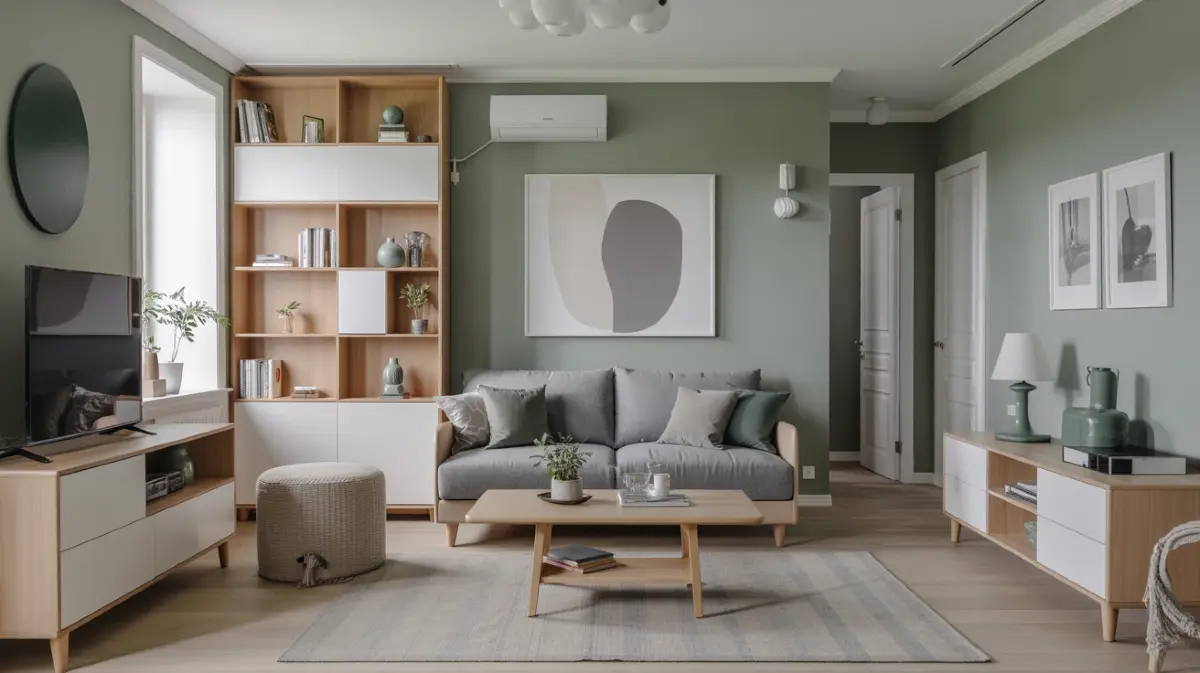
Tailored for the compact footprint of a city apartment, this design is a celebration of intelligent functionalism. It demonstrates that a minimalist, uncluttered aesthetic is not a luxury reserved for large spaces but a practical necessity for small ones.
Every piece of furniture and decor is selected for its ability to serve multiple purposes or save space, embodying the core Scandinavian principle that good design enhances daily life. The resulting environment is not just stylish but also efficient, calm, and psychologically expansive.
The color scheme is a sophisticated base of soft grey walls with crisp white trim, creating a serene and versatile backdrop. Furniture is rendered in light ash wood and medium grey upholstery, maintaining a cohesive and calming feel.
A single, consistent accent color, such as a muted sage green or a dusty slate blue, is used with surgical precision—appearing only in a few textiles and a single piece of artwork to add personality without overwhelming the space.
Multi-functional furniture is the hero of this concept. A sleek, modern sofa features hidden storage compartments beneath its cushions, perfect for stowing away blankets and magazines.
In place of a single bulky coffee table, a “nesting” set of two circular tables offers flexibility; they can be clustered together or separated as needed.
A narrow, floating credenza is mounted on the wall beneath a television, providing essential storage for electronics while keeping the floor clear and creating an illusion of spaciousness. For a work-from-home solution, a wall-mounted, drop-leaf desk can be folded away completely when the workday is over.
Textiles are simple and purposeful. A low-pile wool rug in a dark charcoal grey anchors the seating area, clearly defining the living zone. A few throw pillows adorn the sofa—two in the base grey fabric and one in the chosen sage green accent.
Lighting is strategic and space-saving. A single, elegant arc floor lamp extends over the coffee table, providing ample light for the entire seating area without requiring a ceiling fixture. To enhance the sense of light and space, a large, frameless mirror is placed on the wall opposite the main window, effectively doubling the natural light and visual depth of the room.
3. The Fireside Hyggekrog (Cozy Nook)
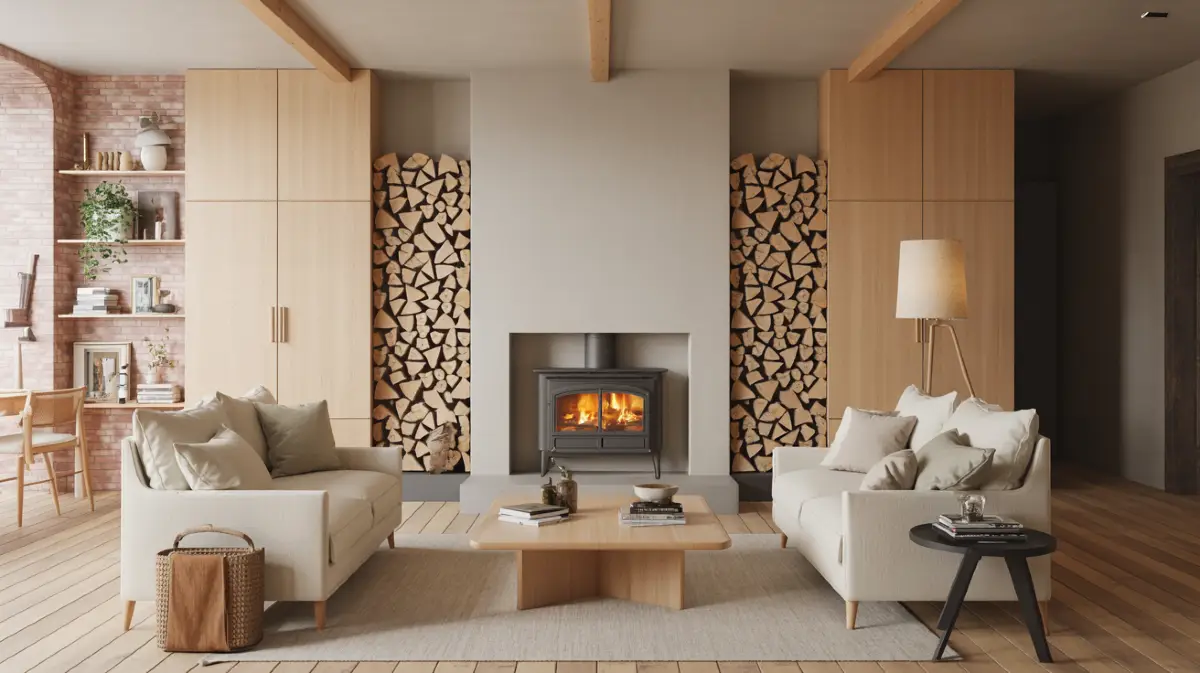
This design concept elevates the fireplace from a mere architectural feature to the undeniable heart and soul of the home. The entire layout and material selection are orchestrated to foster intimacy, quiet conversation, and the ultimate feeling of hygge—a Danish term for a quality of cozy contentment and well-being.
This space is conceived less as a formal living room and more as a sanctuary for unwinding, designed to encourage specific behaviors like reading, relaxing, and connecting with loved ones by the fire’s warm glow.
The centerpiece is a modern, minimalist fireplace, perhaps a freestanding wood-burning stove in black cast iron or a built-in gas unit with a clean, unadorned concrete or plaster surround.
Adjacent to the hearth, a recessed wall niche is neatly stacked from floor to ceiling with split birch logs, serving as both a functional fuel source and a beautiful, rustic design element. The color palette is warm and enveloping, with walls painted in a deep, warm greige (a sophisticated blend of grey and beige) that feels like a soft embrace.
Instead of a traditional sofa, the furniture arrangement is intimate and conversational. Two deep, exceptionally comfortable armchairs with soft, down-filled cushions are positioned to face the fire.
One might be upholstered in a heavily textured oatmeal linen, while the other could be a classic mid-century design in a rich, worn cognac leather, adding a layer of warmth and patina. A large, plush ottoman upholstered in a durable charcoal wool serves as a shared footrest and an informal coffee table; a large, round wooden tray placed on top provides a stable surface for mugs and books.
Textiles are paramount in creating the hygge atmosphere. A large, luxuriously soft faux fur or genuine sheepskin rug is placed directly in front of the hearth, inviting stockinged feet.
Each armchair is appointed with its own dedicated throw blanket: a chunky, hand-knitted cable-knit wool blanket on one, and a Pendleton-style patterned wool blanket in earthy tones on the other. The lighting is designed to be soft and layered.
The primary light source is the flickering fire itself. For ambient light, a single floor lamp with a warm linen shade is tucked into a corner, and the mantelpiece holds a cluster of different-sized white pillar candles, whose gentle glow creates a serene and moody atmosphere. All electric lights are fitted with dimmers to allow for precise mood control.
4. The Naturalist’s Abode
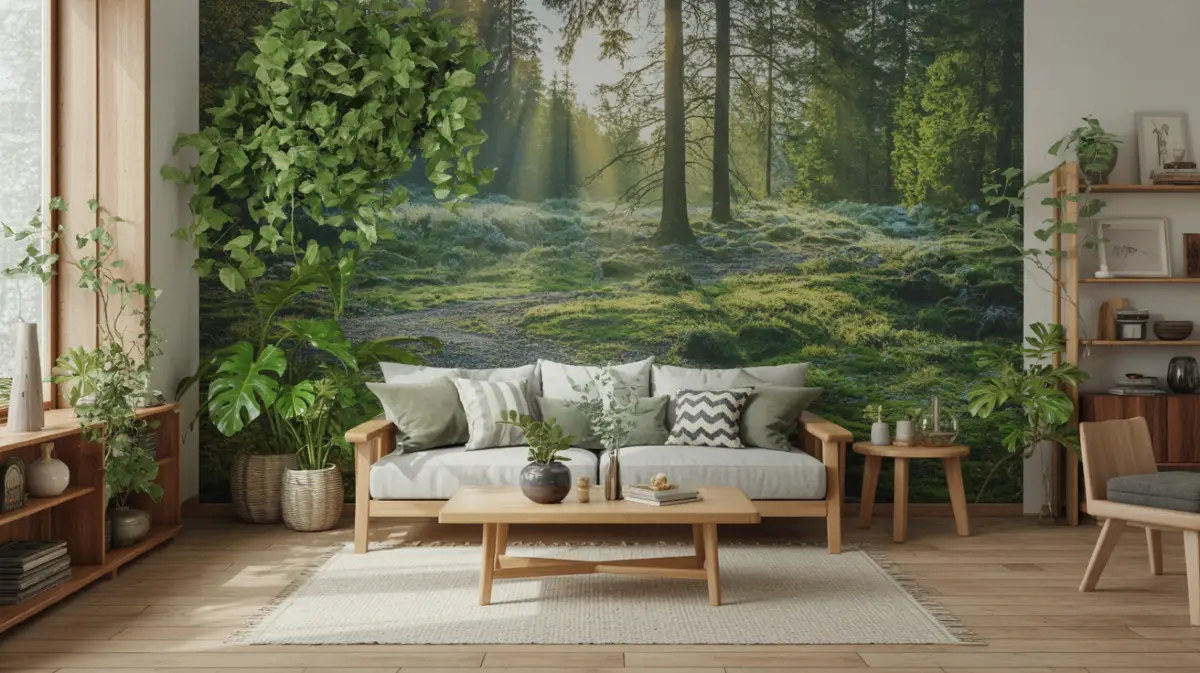
This living room embodies the Scandinavian philosophy of friluftsliv, or “open-air living,” by blurring the boundary between the indoors and the natural world. It is a space that breathes, using a foundation of natural materials and an abundance of living plants to create a fresh, vibrant, and deeply calming atmosphere.
This approach is rooted in the understanding that a connection to nature is essential for well-being, making the plants not just decorative accessories but functional elements that improve air quality and contribute to a serene state of mind.
The backdrop is deliberately simple to allow the natural elements to take center stage. Crisp white walls act as a gallery-like canvas for the rich greens of the foliage and the warm tones of the wood.
The color palette is drawn directly from a forest landscape: the varied greens of leaves, the earthy browns of wood and soil, and the cool grey of stone. Light-colored wood is the dominant material, seen in the wide-plank ash or white oak flooring and furniture crafted from birch and rattan.
A coffee table with a cool, smooth travertine stone top introduces another natural texture.
The furniture is simple and clean-lined, upholstered in durable, natural fabrics. A comfortable sofa in a light grey linen-blend provides a neutral anchor.
A woven rattan armchair with a soft white cushion adds a touch of organic texture. The “decor” is almost entirely composed of plants, curated for their varied shapes and sizes. A large, statement Fiddle Leaf Fig with its bold, sculptural leaves commands a corner , while a Monstera Deliciosa is placed next to the sofa.
A series of solid wood floating shelves, installed at different heights, hosts a collection of trailing plants like Golden Pothos and String of Pearls, their vines cascading down the white wall.
A long, low bench made of solid pine runs the length of the main window, serving as a versatile surface for a row of smaller plants and occasional seating. All plants are housed in simple terracotta or white ceramic pots, maintaining a cohesive and earthy aesthetic.
Maximizing natural light is crucial for both the plants and the room’s atmosphere. The large windows are left as bare as possible, dressed only with simple, retractable white blinds that can disappear from view. For evening lighting, a single, large, dome-shaped pendant light made from woven bamboo hangs over the central seating area, casting a warm, patterned glow.
5. Wabi-Sabi Serenity
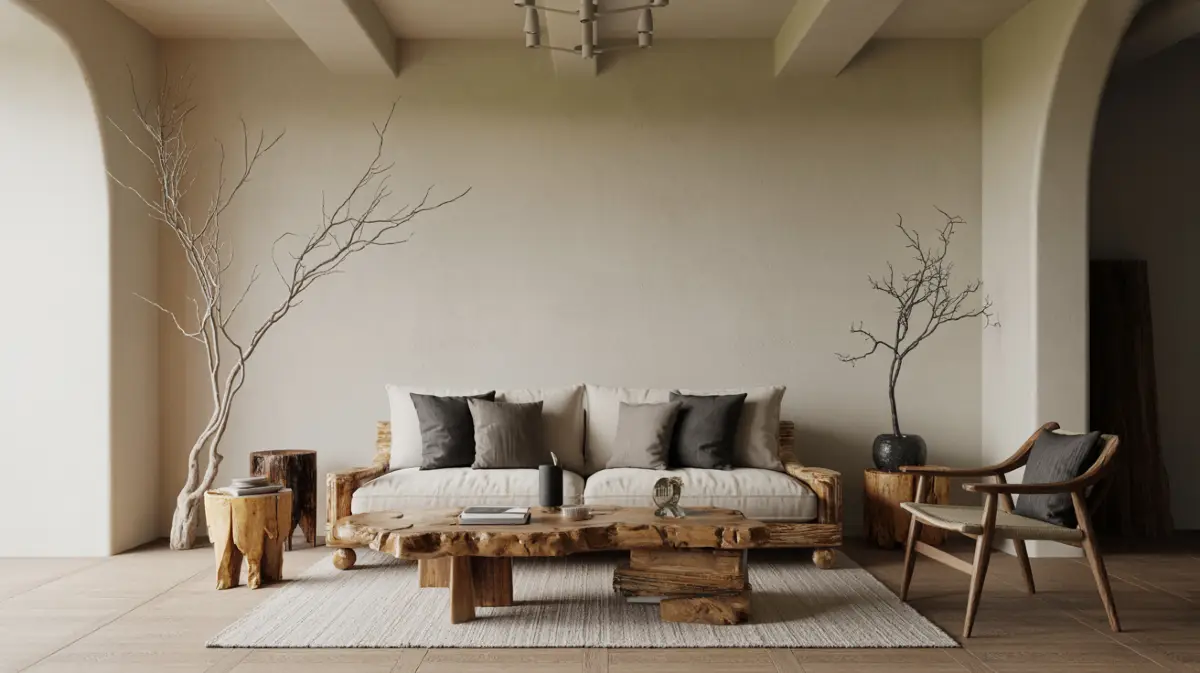
This design concept is a physical manifestation of the Japanese philosophy of wabi-sabi—the art of finding beauty in imperfection, transience, and the authentic character of natural materials.
It is a space that feels deeply soulful and lived-in, rejecting the coldness of mass production in favor of objects that bear the mark of the artisan and the passage of time. The room celebrates asymmetry, simplicity, and the unique story embedded in every knot, crack, and patina.
The palette is muted, earthy, and textural. The walls are finished with a tactile lime wash or plaster in a warm off-white or light beige, giving them a soft, imperfect depth that changes with the light. The material palette is a rich contrast of smooth, pale Scandinavian oak and darker, more rustic reclaimed wood. Accents of charcoal black and deep indigo provide grounding and contrast.
Furniture is low-profile and thoughtfully chosen. A simple, clean-lined sofa is upholstered in a natural, unbleached linen fabric that will soften and wrinkle with use.
The coffee table is the room’s central wabi-sabi statement: a thick, heavy slab of reclaimed wood with a live edge, its surface showcasing the wood’s history through visible knots and cracks. A single accent chair, perhaps a Danish design with a dark-stained wood frame and a woven paper cord seat, highlights the value of craftsmanship.
Textiles are natural and feature subtle imperfections. A large, nubby wool rug in a solid charcoal grey anchors the space. Throw pillows are crafted from vintage Japanese textiles, such as indigo-dyed Shibori fabric with its unique, organic patterns.
A simple, lightweight throw made of crinkled linen is draped over the sofa. Decor is highly curated and intentional, following the “less is more” principle. A single, dramatically asymmetric branch is placed in a tall, handcrafted ceramic vase, the vase itself being slightly irregular in shape and glaze.
A collection of mismatched, handmade ceramic tea cups rests on a simple wooden tray. The primary light source is a large, spherical paper lantern, reminiscent of an Isamu Noguchi Akari light sculpture, which hangs low over the coffee table and emits a warm, diffused, and gentle glow.
6. The Light and Shadow Study
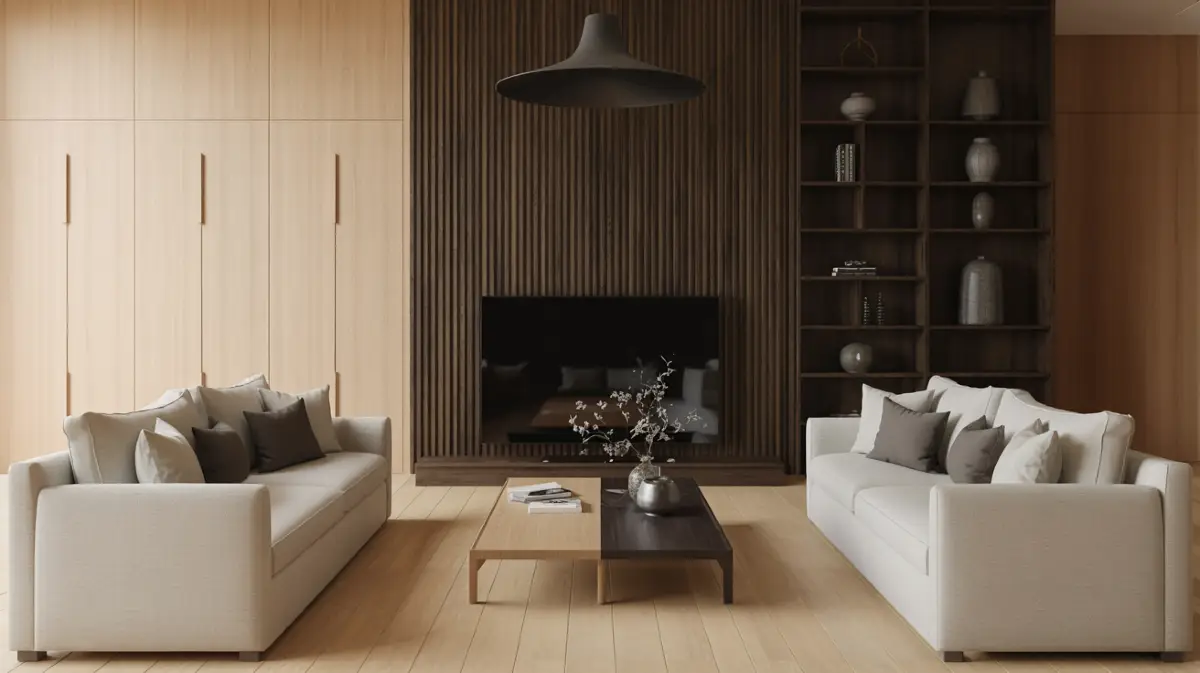
This Japandi concept is built on the powerful interplay of contrast—between light and dark, smooth and rough, solid and void. It uses a carefully balanced palette of pale Scandinavian woods and dark, dramatic Japanese-inspired elements to create a space that is both serene and visually dynamic.
The design draws on the traditional Japanese appreciation for shadow (in’ei raisan) as an integral part of beauty, crafting an atmosphere that is meditative, sophisticated, and deeply calming.
The color scheme is a study in controlled contrast. Walls are a soft, warm white, providing a luminous backdrop. The flooring is a pale, wide-plank oak. This light base is punctuated by strong, dark elements.
A feature wall might be clad in vertical slats of dark-stained cedar or black-painted wood, adding depth and textural interest. Furniture combines both light and dark woods, creating a harmonious dialogue between the two aesthetics.
The furniture is defined by its low profile and clean, geometric lines. A long, low-slung sofa with a minimalist wooden frame and dark charcoal upholstery grounds the space. The coffee table could be a dark-stained oak piece with a simple, rectilinear form.
To divide the space or screen a view, a freestanding shoji-inspired screen with a black wooden frame and translucent rice paper panels can be used, allowing light to filter through while creating a sense of separation and mystery. Seating is kept close to the ground to foster a feeling of connection to the earth, a common principle in Japanese interiors.
Textural layers soften the clean lines. A low-pile rug in a neutral beige or grey defines the seating area. Cushions in solid, muted tones like olive green or deep blue add a subtle touch of color.
Lighting is strategically placed to create pools of light and areas of shadow. A sculptural floor lamp with a dark metal base and a simple fabric shade provides task lighting, while concealed LED strips along the base of the slatted wall can create a dramatic grazing effect, highlighting its texture.
Natural light is controlled and framed, with windows treated as picture frames for the view outside.
7. The Sustainable Sanctuary

This living room is designed around the core Japandi principles of sustainability, longevity, and respect for nature. It prioritizes high-quality, ethically sourced materials and timeless, artisan-crafted furniture over disposable, trend-driven items.
This is a space for the conscious consumer, reflecting a commitment to environmental responsibility and a desire to create a healthy, non-toxic home. The aesthetic is one of natural, understated elegance, where the beauty of the materials and the quality of the craftsmanship speak for themselves.
The material palette is exclusively natural and renewable. Bamboo, a fast-growing and highly sustainable grass, is used for flooring or as an accent on furniture. Rattan and cork, both renewable resources, appear in chairs and side tables.
Textiles are organic and undyed, including linen, cotton, and hemp for curtains, upholstery, and cushions. The color palette is derived from these natural materials: the warm tones of bamboo and cork, the creamy whites of organic cotton, and the earthy beige of linen.
Furniture is selected with a “buy once, buy well” mentality. Pieces are made from solid, FSC-certified wood, ensuring they come from responsibly managed forests.
The design favors timeless forms that will not fall out of style, such as a simple, well-made sofa with a removable, washable linen cover for longevity. Storage solutions are integrated and clever, such as a rustic ottoman with a lift-off top or a coffee table with hidden drawers, promoting a clutter-free environment.
Decor emphasizes handcrafted and recycled items. Vases and bowls are made from recycled glass or handcrafted terracotta by local artisans. A large, woven rug made from natural jute or sisal adds texture and an organic feel.
Indoor plants are essential for their air-purifying qualities and connection to nature; choices might include a snake plant or a ZZ plant, both known for their hardiness and air-cleaning properties.
The lighting is energy-efficient, using LED bulbs in fixtures made from natural materials like paper, wood, or ceramic. This approach creates a space that is not only beautiful and serene but also nurturing for both its inhabitants and the planet.
8. The Zen Minimalist’s Lounge

This concept represents the most distilled form of Japandi, pushing the boundaries of minimalism to create a space of profound tranquility and focus. It is designed for meditation, quiet contemplation, and intentional living.
The philosophy here is to remove everything extraneous, leaving only the most essential, high-quality pieces. The power of this design lies in its use of negative space—the empty areas are just as important as the objects within them, creating a sense of calm and uncluttered clarity.
The palette is strictly neutral and monochromatic, relying on subtle shifts in tone and texture for interest. The walls are a soft, warm white. The floor might be a seamless, light grey micro-cement or pale, knot-free maple wood. The overall effect is one of quiet harmony and unity.
There are only a few pieces of furniture, each chosen for its flawless craftsmanship and sculptural form. A very low-profile platform sofa, perhaps just a simple wooden base with comfortable, tailored cushions in a light grey fabric, is the primary seating.
There might not be a traditional coffee table, but rather two small, movable wooden stools or a single, perfectly smooth river stone that can serve as a surface. A single, exquisitely designed lounge chair provides a secondary seating option. Every piece is a work of art in its own right, intended to be appreciated for its form and material.
There are almost no decorative objects. The walls are left largely bare to emphasize the sense of space.
The single piece of adornment might be a large, unframed canvas with a single, powerful brushstroke—an ensō circle, a Zen symbol of enlightenment and the universe—or a piece of Japanese calligraphic art.
A single, perfectly pruned bonsai tree on a low pedestal connects the space to nature in a highly controlled and artistic way. Textiles are minimal: a simple linen throw and a few solid-colored cushions. The focus is on creating a pure, serene environment that quiets the mind and allows for a deeper connection with oneself.
9. The Moody Monochrome
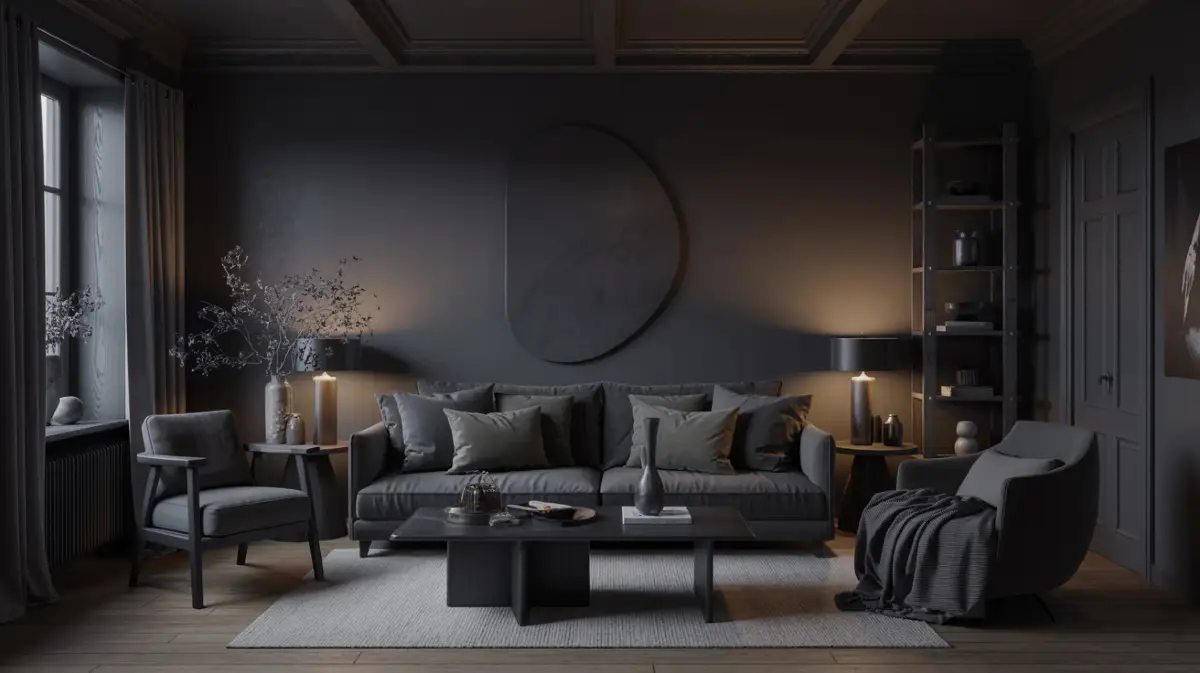
This design challenges the stereotype of the all-white Scandinavian interior by embracing a dark, dramatic, and sophisticated monochrome palette.
It proves that cozy minimalism can be achieved through deep, enveloping colors when balanced with soft textures, warm materials, and strategic lighting. The result is a space that feels like a chic, intimate cocoon—perfect for evening relaxation and conversation.
The palette is a rich spectrum of charcoals, deep greys, and soft blacks. The walls are painted in a matte, dark charcoal grey, which absorbs light and creates an immediate sense of intimacy.
The trim and ceiling might be a slightly lighter shade of grey to create subtle definition without harsh contrast. To prevent the space from feeling heavy, the flooring is a contrasting light or medium-toned wood, such as oak, which brings essential warmth and a natural element to the dark scheme.
Furniture is selected for its clean lines and luxurious materials. A slim-profile sofa upholstered in a dark grey velvet or a rich, worn black leather provides a comfortable yet elegant centerpiece.
A coffee table made of black-stained wood or dark metal adds to the cohesive look. To introduce warmth and a touch of glamour, accent pieces feature warm metals like brushed brass or bronze. An arc lamp in brass, for example, can provide both a sculptural element and a warm light source.
Texture is critical in a monochrome space to prevent it from feeling flat. A plush, high-pile wool rug in a medium grey adds softness underfoot. Throw pillows in different materials—a faux fur, a chunky knit, and a smooth silk or leather—add tactile variety.
A cognac leather armchair can be introduced as a warm, contrasting accent, breaking up the grey and black while tying into the warm metallic tones. Lighting is carefully layered to create a warm, inviting glow against the dark walls. Multiple sources like table lamps with linen shades, dimmable spotlights on artwork, and plenty of candles are used to create a moody and sophisticated ambiance.
10. The Earthy Palette
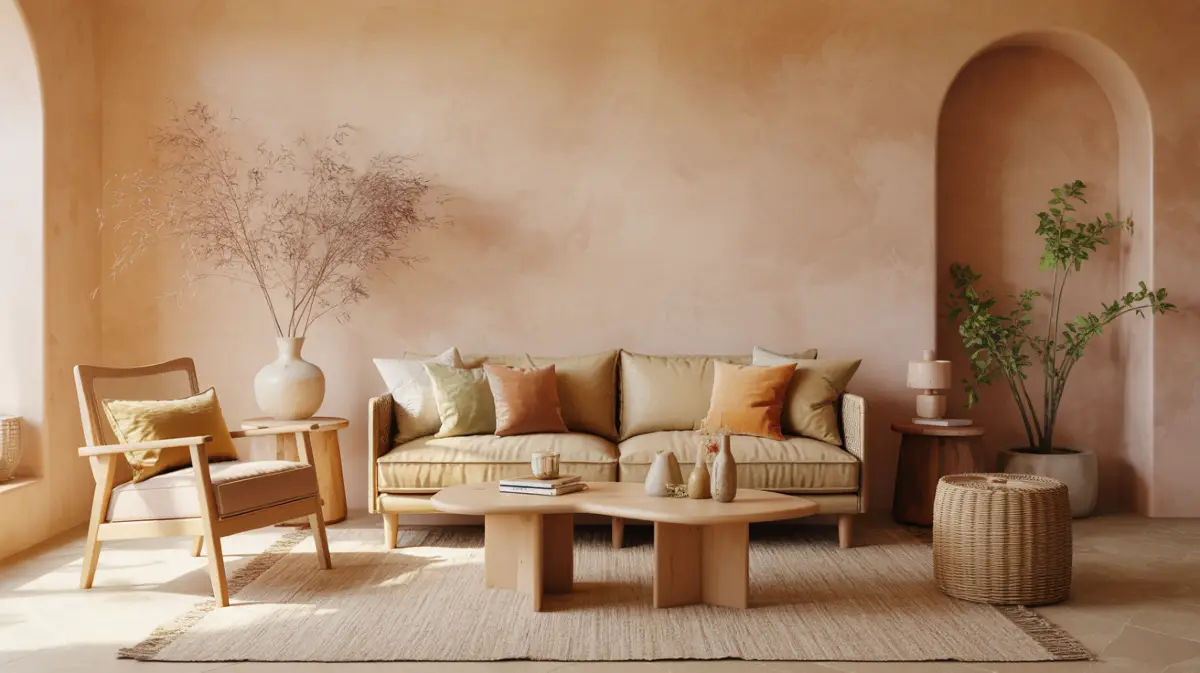
Moving away from the cooler tones often associated with Scandinavian design, this concept embraces a warm, inviting palette inspired by the natural world. It is built around earthy tones like terracotta, muted sage green, and warm beige, creating a space that feels grounded, nurturing, and deeply connected to nature. This approach showcases a softer, more rustic side of Scandinavian style, perfect for those who find comfort in natural, sun-baked hues.
The color story begins with walls in a warm, creamy beige or a soft, earthy terracotta plaster finish. These colors provide a warm, radiant backdrop that feels both cozy and sophisticated. The furniture is a mix of light wood and natural upholstery.
A comfortable, deep-seated sofa in a durable beige or oatmeal linen-blend fabric is the foundation of the seating area. An accent chair upholstered in a muted sage green velvet or a rich rust-colored fabric adds a pop of earthy color.
Natural materials are central to this look. A large jute or sisal rug anchors the space, its rough texture contrasting beautifully with the softer fabrics. The coffee table might be a solid, rustic wood piece or a modern design with a travertine top. Terracotta pots holding green plants like olive trees or snake plants are scattered throughout the room, reinforcing the connection to the earth.
Textiles are layered for comfort and visual interest. Cushions feature simple, nature-inspired patterns or solid colors in the earthy palette. A lightweight, gauzy linen throw in a natural, unbleached tone is draped over the sofa.
Decor is minimal and artisanal, with an emphasis on handmade ceramics, wooden bowls, and dried botanicals like pampas grass or eucalyptus branches in a simple vase. The overall effect is a serene, welcoming space that feels both modern and timeless, evoking the calm of a Mediterranean villa with the clean simplicity of a Nordic home.
11. The Scandi-Boho Collector’s Corner

This design offers a minimalist’s interpretation of the free-spirited bohemian style. It merges the clean, functional foundation of Scandinavian design with the eclectic, personal, and layered aesthetic of boho decor.
The key to this fusion is curation and restraint. Instead of the typical bohemian profusion of color and pattern, this style uses a neutral Scandi base as a canvas for a thoughtfully selected collection of meaningful textiles, vintage finds, and personal art, creating a space that is both calm and full of personality.
The foundation is pure Scandinavian: white or light grey walls, light wood floors, and a simple, clean-lined sofa in a neutral fabric like light grey or beige. This creates a calm, uncluttered backdrop that prevents the eclectic elements from feeling chaotic.
The “boho” layers are then added intentionally. A vintage Persian or Moroccan rug with a faded, intricate pattern can be used to anchor the seating area, introducing color and history.
Textiles are a key feature. The neutral sofa is adorned with a mix of pillows: some with macrame or tassel details, others made from vintage Kilim textiles or featuring subtle geometric patterns.
A soft, hand-woven throw blanket adds another layer of texture. A classic boho element like a hanging rattan chair can be included in a corner, providing a cozy and playful reading nook.
The decor tells a personal story. A gallery wall features a mix of personal photographs, abstract art, and framed textiles, all in simple wood or black frames for a cohesive look. Houseplants are abundant, but instead of being randomly placed, they are grouped thoughtfully—a large palm in a woven basket on the floor, a collection of succulents on a floating shelf.
Vintage pieces, like a mid-century modern credenza or a brass side table, add character and a sense of history. The space feels collected and personal, yet remains airy and uncluttered thanks to its strong Scandinavian bones.
12. The Sculptural Simplicity
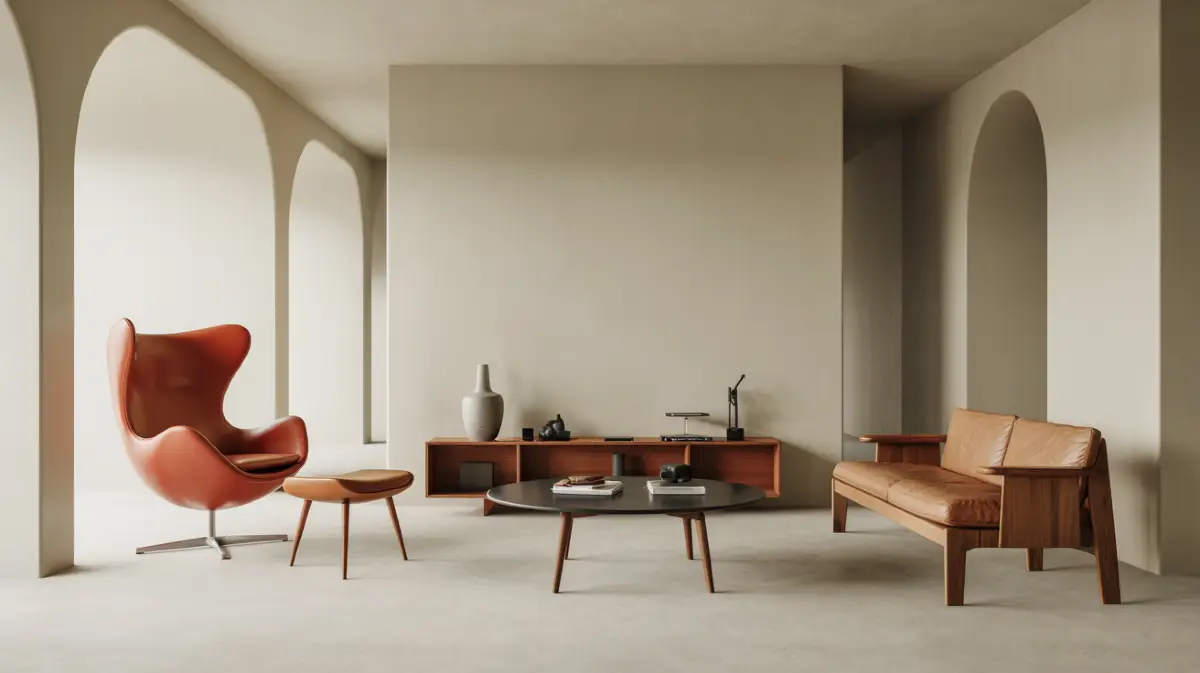
This living room design approaches furniture and decor as functional art. It is a highly curated space that celebrates the beauty of form, material, and iconic design. The principle here is “fewer, better things.”
Instead of filling the room, a few exceptional pieces are chosen for their sculptural quality and allowed to shine in a minimalist setting. This concept is perfect for the design aficionado who appreciates the history and artistry of mid-century Scandinavian modernism.
The environment is gallery-like, with smooth white walls and polished concrete or light wood floors providing a neutral stage for the design pieces. The layout is open and uncluttered, with ample negative space around each piece of furniture to highlight its unique silhouette.
The centerpiece might be an iconic lounge chair, such as an Arne Jacobsen Egg Chair in a bold color like red or a classic cognac leather, or a Hans Wegner Papa Bear Chair. This single piece acts as the room’s primary sculpture.
The sofa is deliberately understated—a simple, low-profile design with clean lines and neutral grey upholstery—so as not to compete with the statement chair. The lighting is also a sculptural element. A classic Castiglioni-style arc floor lamp with a marble base dramatically sweeps over the seating area, providing both light and a powerful graphic line in the space.
Decor is minimal and impactful. A single, large-scale abstract painting with bold colors or shapes hangs on the main wall, creating a focal point. The coffee table is a simple, low glass or marble piece that doesn’t obstruct the view of the other items.
A few carefully chosen art books might be the only objects on its surface. This design is a testament to the idea that a room’s character can be defined by a few masterfully designed objects, creating a space that is both simple and profoundly sophisticated.
13. The Glass and Steel Pavilion
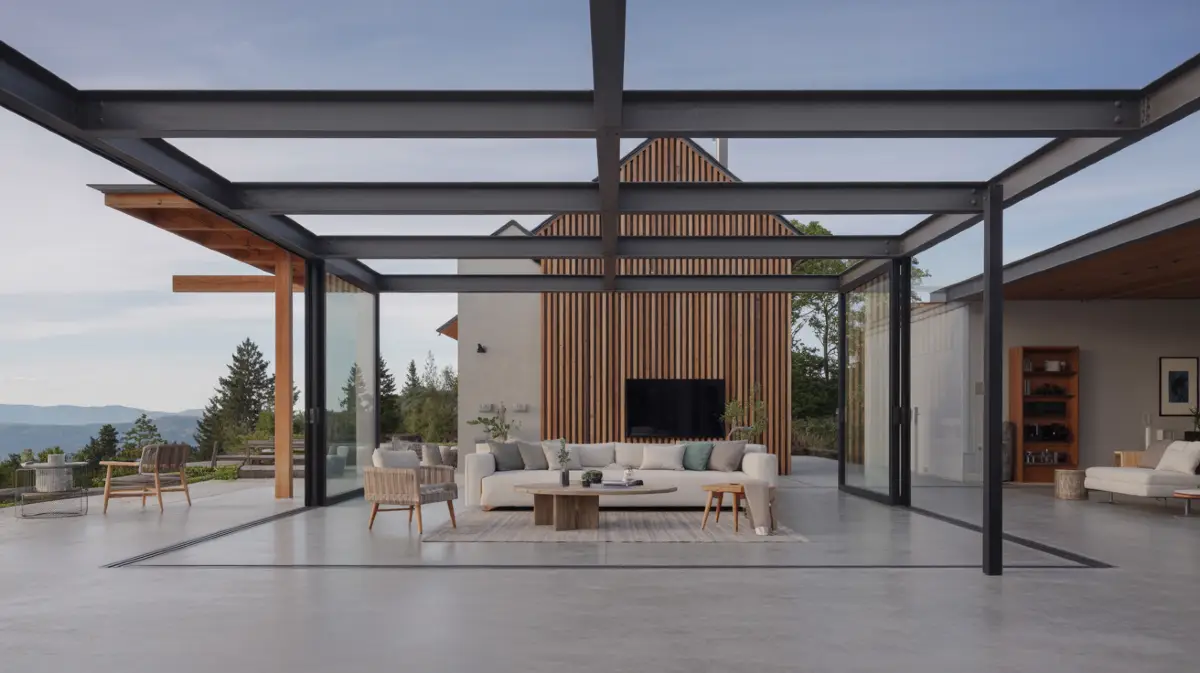
This concept is tailored for a modern home with an architectural emphasis on open-plan living and a strong connection to the outdoors, often featuring floor-to-ceiling windows or large glass walls.
The design challenge is to balance the inherent coolness of materials like glass, steel, and concrete with the warmth and comfort essential to a living space. This is achieved by introducing soft textures, natural wood, and plush furnishings to create an inviting sanctuary within a modern architectural shell.
The architectural elements set the tone: exposed steel beams, polished concrete floors, and vast expanses of glass that frame views of the surrounding landscape. The color palette is kept simple and neutral to avoid competing with the view.
Walls are white or a very light grey. The coolness of the industrial materials is immediately balanced by the use of warm wood for key elements, such as a feature wall clad in vertical oak slats or a large, custom-built wooden shelving unit.
The furniture is chosen for its ability to add softness and comfort. A large, deep, modular sofa upholstered in a soft, textured fabric like chenille or a wool blend invites lounging. The scale of the sofa is important—it needs to be substantial enough to hold its own in a large, open space.
A massive, plush area rug with a thick pile is essential to define the seating area, absorb sound, and provide warmth and softness underfoot. A round, solid wood coffee table adds an organic shape to contrast with the hard lines of the architecture.
Layers of textiles are crucial for coziness. The sofa is piled with oversized, comfortable pillows and several soft, luxurious throws, perhaps in cashmere or merino wool. A pair of comfortable armchairs, perhaps in a soft leather or bouclé, completes the seating arrangement.
Lighting is warm and ambient, with floor lamps and table lamps creating intimate pools of light in the evening, making the large space feel more intimate and human-scale. The result is a harmonious blend of modern architecture and cozy living, where the clean lines of the structure are softened by the comforting embrace of the furnishings.
14. The Open-Plan Flow
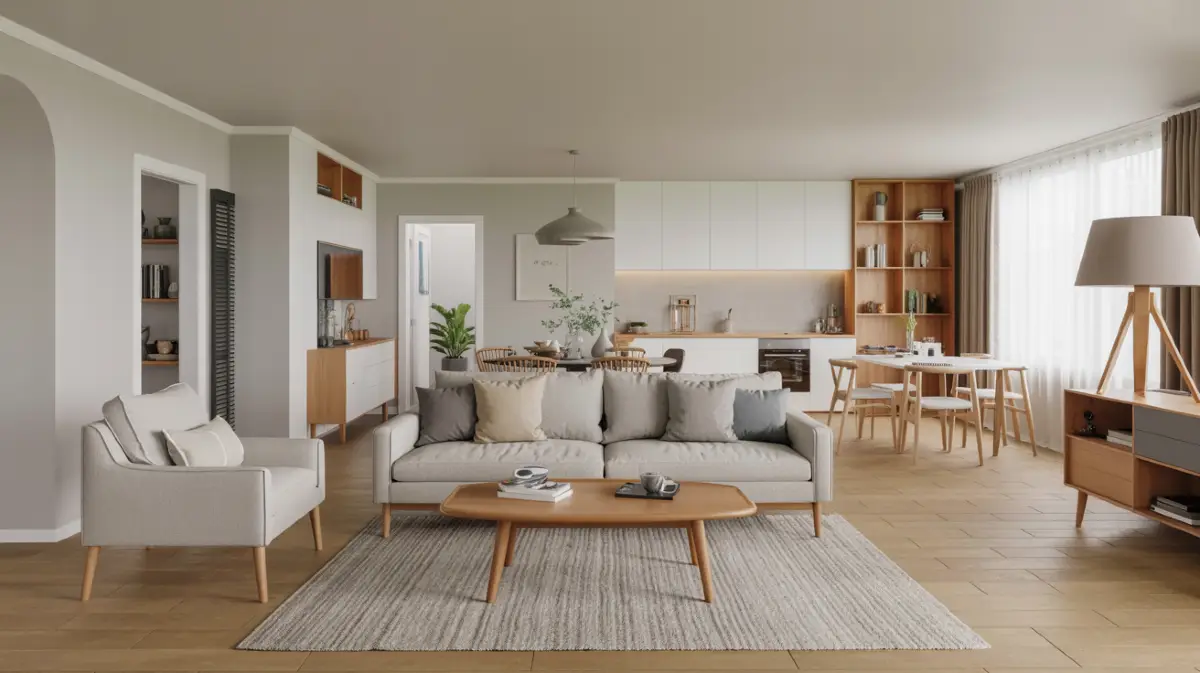
In many modern homes, the living room is not a separate, enclosed space but part of a larger, open-plan area that may include the kitchen and dining room. This design focuses on creating a cohesive yet clearly delineated living area within this open concept.
The goal is to establish a sense of intimacy and purpose for the living zone without building walls, using clever furniture arrangement, rugs, and subtle shifts in the neutral palette to create “rooms within a room.”
The overall color palette for the entire open-plan space is kept consistent and neutral—shades of white, grey, and beige—to create a sense of flow and unity.
The living area is then defined primarily by a large area rug. This rug acts as a visual anchor, with all the living room furniture—sofa, chairs, coffee table—having at least their front legs on it. This simple trick creates a clear boundary for the “living room.”
The furniture arrangement is key to creating both definition and flow. A sectional sofa with a chaise can be used to create a soft “wall,” separating the living area from a dining space or walkway.
The back of the sofa should be low enough not to obstruct sightlines completely, maintaining the open feel. A slim console table placed behind the sofa can further define this edge and provide a surface for lamps or decor.
Subtle variations in texture and tone can also help delineate zones. While the overall wall color is consistent, the living area might feature a slightly deeper shade of grey on an accent wall or introduce a different texture, like wood paneling.
Lighting also plays a crucial role. A distinct pendant light or chandelier hanging over the seating area gives it its own identity and creates a more intimate atmosphere in the evening. This approach ensures that the living room feels like a cozy, dedicated space for relaxation, even within a large, multi-functional room.
15. The Family-Friendly Minimalist Room

This concept debunks the myth that minimalism is incompatible with family life. It demonstrates how to create a Scandinavian living room that is stylish, uncluttered, and cozy, while also being durable, safe, and practical for a household with children. The key is to choose smart materials, incorporate ample, accessible storage, and select furniture with soft lines.
Durability is paramount. The sofa is upholstered in a high-performance, stain-resistant fabric in a forgiving color like a medium grey or a heathered weave that can hide minor spills. Alternatively, a sofa with removable, machine-washable covers is an excellent choice.
Surfaces are chosen for their resilience; a coffee table made of solid wood can be sanded and refinished if scratched, and its edges should be rounded for safety. Instead of a hard coffee table, a large, firm upholstered ottoman can serve as both a surface (with a tray on top) and a soft place for kids to play.
Stylish, integrated storage is the secret to maintaining a minimalist look. A long, low, floating credenza provides ample space to hide toys, games, and electronics out of sight. Woven baskets are perfect for quickly tidying up smaller items and can be tucked away on shelves or under a console table. The design embraces the idea that a clutter-free space is calming for both adults and children.
The overall aesthetic remains true to Scandinavian principles. The color palette is light and neutral, creating a calm environment.
A soft, washable area rug defines the play and seating area. Artwork can include children’s own creations, elegantly framed and hung in a gallery wall format, celebrating their creativity while maintaining a curated look. This design proves that a family home can be a beautiful, serene, and functional sanctuary for everyone.
16. The Bibliophile’s Nook

For the avid reader, this living room design integrates a love of books directly into the architecture and decor of the space. It transforms bookshelves from simple storage units into a major design feature, creating a warm, personal, and library-like atmosphere that is the epitome of cozy. The room is designed to be a comfortable and inviting haven for reading and quiet reflection.
The main architectural feature is a wall of floor-to-ceiling bookshelves. To maintain a clean, Scandinavian look, the shelves are built-in and painted the same color as the walls—perhaps a soft white or a warm grey.
This makes the books themselves, with their varied colors and textures, the primary decorative element. The shelves can be arranged in a clean grid or a more dynamic, asymmetrical pattern for added visual interest.
The furniture is arranged to create the perfect reading environment. A deep, comfortable armchair or a small chaise lounge upholstered in a soft, durable fabric like wool or velvet is placed in a corner near the bookshelves.
This dedicated reading spot, or hyggekrog, is completed with a small side table for a cup of tea and a high-quality, adjustable floor lamp that provides excellent task lighting for reading.
The rest of the room complements the library theme. A simple, comfortable sofa provides seating for conversation and socializing. The color palette is kept relatively neutral to allow the books to stand out.
Textures are warm and inviting: a soft wool rug, plush velvet cushions, and a cozy knit throw. The decor is minimal, consisting mainly of the books themselves, perhaps with a few small, meaningful objects placed on the shelves. This design celebrates the intellectual and aesthetic beauty of books, creating a living room that is both a social space and a deeply personal retreat.
17. The Coastal Scandi Escape

This concept draws inspiration from the serene and rugged coastlines of the Nordic countries. It combines the light, airy principles of Scandinavian design with a coastal palette of soft blues, sandy beiges, and weathered woods. The result is a tranquil, breezy living room that feels like a peaceful seaside retreat, perfect for relaxation and escaping the stresses of daily life.
The color palette is light and calming, evoking a misty day by the sea. The walls are painted a crisp white or a very pale, cool grey. The dominant accent color is a muted, dusty blue, used for throw pillows, a soft blanket, or a piece of artwork. Warmth is introduced through sandy beige tones in the rug and upholstery, and the natural color of light, weathered wood.
Materials are natural and textural. The flooring might be a light, whitewashed oak or ash, reminiscent of driftwood. Furniture is made from light-colored woods with a raw or matte finish. A comfortable sofa is upholstered in a relaxed, light beige or off-white linen slipcover. An accent chair could be made of woven rattan or feature a simple wooden frame with blue and white striped cushions.
The decor emphasizes the coastal theme in a subtle, sophisticated way. Instead of overt nautical motifs, the feeling is evoked through texture and color. Sheer, white linen curtains billow softly in the breeze from an open window, maximizing natural light and creating a sense of airiness.
A large, round jute rug adds a sandy, textural element. Decorative objects might include smooth, grey stones collected from a beach, a vase filled with tall, feathery pampas grass, and black-and-white photography of seascapes. The overall atmosphere is one of effortless calm and understated elegance, bringing the restorative power of the coast indoors.
18. The High-Contrast Graphic Look
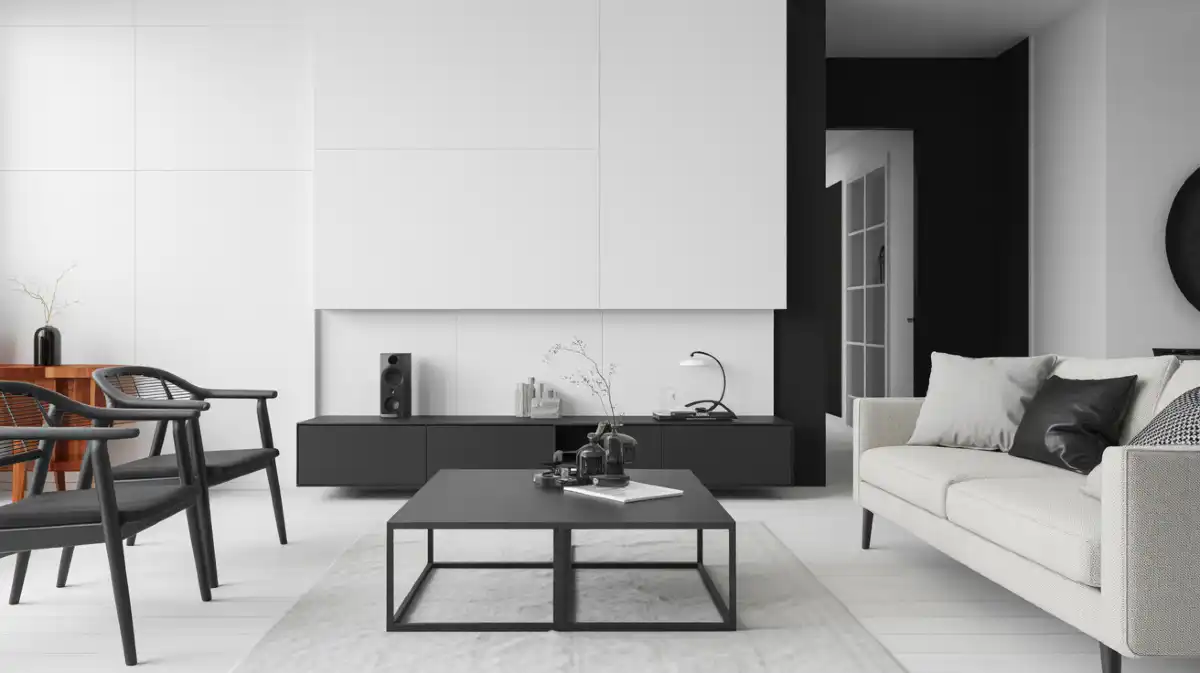
This is a bolder, more contemporary take on Scandinavian design that plays with the strong graphic contrast of black and white. While still rooted in minimalism and functionality, this style uses clean lines, geometric patterns, and a starkly limited color palette to create a space that is visually striking, modern, and sophisticated. The key to keeping it cozy is the careful inclusion of warm wood tones and soft textures to balance the sharp contrast.
The foundation is a crisp, graphic palette of pure white and matte black. The walls are bright white, creating a high-contrast backdrop for black elements. The black is used strategically to create focal points and define shapes. This could be in the form of black window frames, a black metal-framed coffee table, or a sleek, black media console.
Furniture is chosen for its clean, modern lines. A sofa in a light grey fabric acts as a neutral bridge between the black and white extremes.
The legs of the sofa and chairs are often slim and made of black metal or dark-stained wood, reinforcing the graphic look. A classic Scandinavian lounge chair with a black leather seat and a light wood frame perfectly encapsulates the style’s balance of contrast and warmth.
Geometric patterns are used as accents on textiles. A flat-weave rug might feature a simple black and white diamond or stripe pattern. Cushions could have bold, abstract graphic prints. To prevent the space from feeling too sterile, natural wood is an essential warming element. Light oak or ash flooring provides a natural, warm base.
A few decorative objects made of wood, such as a bowl or a picture frame, also help to soften the look. Greenery in simple black or white pots adds a touch of life and organic form to the otherwise linear and graphic space.





